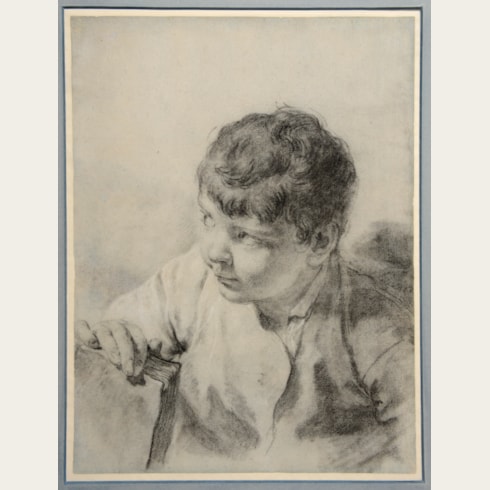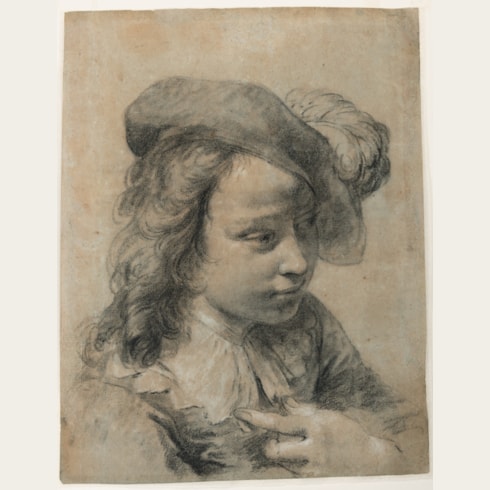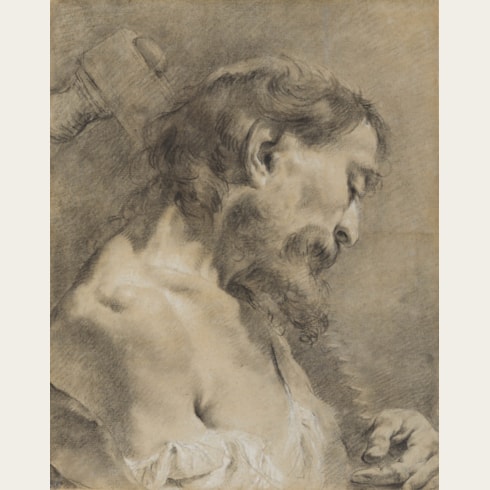Giovanni Battista PIAZZETTA
(Venice 1682 - Vencie 1754)
A Boy Playing a Lute [recto]; Study of a Right Arm [verso]
A strip of paper added along the left edge.
378 x 282 mm. (14 7/8 x 11 1/8 in.) [sheet]
RECENTLY ACQUIRED BY THE FINE ARTS MUSEUMS OF SAN FRANCISCO.
The scholar Andrew Robison has observed that, ‘Beyond the obvious beauty of his drawings of heads, Piazzetta’s ability to endow them with so many of his distinctive qualities helps explain their enormous popularity not only with collectors but also with his most thoughtful contemporaries.’ Indeed, as early as 1733, the Venetian critic and connoisseur Anton Maria Zanetti the Younger had noted of the teste di carattere that they were the most beautiful drawings of this type he had ever seen (‘più belle delle quali in questo genere altre son se ne sono mai vedute’). Piazzetta, who as a painter worked very slowly, seems to have produced these large, bust-length drawings of character heads as a means of earning a steady income to support himself and his family. Indeed, the 18th century French amateur Antoine-Joseph Dézallier d’Argenville, writing in 1762, noted that Piazzetta claimed to have earned the sum total of 7,000 zecchini from his drawings of heads. Certainly, the fact that the artist’s reputation outside Venice was well established by the early 1720s can be credited to his teste di carattere drawings, many of which were engraved by the Venetian printmaker Marco Pitteri, whose prints served to spread their fame. As a modern scholar has written of these drawings, ‘Because they are so fully worked out, they are almost substitutes for paintings and give the impression that the artist was trying to reach, in a complex drawing, the absolute perfection of finish that is characteristic of his paintings...As an artist, he also had a marked preference for the faces of children and young people, and probably based his drawings of these on his own children or prentice boys working in his studio.’ A large group of Piazzetta’s teste di carattere drawings, amounting to thirty-six sheets, once belonged to the British Consul in Venice Joseph Smith – who probably purchased them directly from the artist – and is now in the Royal Library at Windsor Castle.
While Piazzetta may have used studio assistants or members of his family as models, his teste di carattere drawings are not usually portraits as such. Although almost none of these character studies of heads are dated, the artist seems to have drawn them throughout his career. George Knox has dated some to the decade of the 1720s, while others may be dated to the 1730s by virtue of the fact that an inventory of the collection of Piazzetta’s patron Marshal Johann Matthias von der Schulenberg notes that the artist supplied several such drawings to him at this time. Further drawings of this type, in which Piazzetta seems to have depicted his children, may be dated to the late 1730s and 1740s; some of these were engraved by Giovanni Cattini and published as Icones ad vivum expressae in 1743.
Drawings of youths playing musical instruments were a favourite subject of Piazzetta’s. Among similar examples by the artist are A Boy with a Lute in the National Gallery of Art in Washington, D.C. and a Boy with a Recorder in the Harvard University Art Museums in Cambridge, Massachusetts. Another teste di carattere study of a youth with a lute, in the Wallraf-Richartz Museum in Cologne, is considerably weaker in handling than most drawings of this type and is likely to be by a follower of Piazzetta. The features of the youth in the present sheet are close to those in Piazzetta’s painting of A Boy in Polish Costume of c.1741 in the Museum of Fine Arts in Springfield, Massachusetts.
The drawing on the verso of this sheet might be somewhat earlier that the character head on the recto, however, since the study of a right arm appears to be preparatory for the upraised arm of Helen in Piazzetta’s early canvas of The Abduction of Helen of c.1718, today in the Musée Granet in Aix-en-Provence. The large painting, which has been cut at the right edge, was previously attributed to the 18th century French artists Jean-Baptiste Marie Pierre and Michel-François Dandré-Bardon, before being correctly identified as a youthful work by Piazzetta by the art historian Nicola Ivanoff in 1965. Interestingly, Piazzetta adapted the head of Helen from the Musée Granet painting in another early testa di carattere, adding an asp and thereby changing the subject to that of Cleopatra; that drawing was formerly in the Alverà collection and is today in the Galleria dell’Accademia in Venice. A similar treatment of an arm and hand as that on the verso of this sheet is found in a red chalk drawing of a reclining female nude by Piazzetta which was on the art market in 1994.
Active as a painter, draughtsman, printmaker and book illustrator, Giambattista Piazzetta was first trained by his father, a sculptor, and later was a pupil of Antonio Molinari. A brief stay in Bologna between 1703 and 1705 introduced him to Giuseppe Maria Crespi, whose paintings, like those of Guercino and the Carracci, were to have a particular influence on Piazzetta’s early work. Back in Venice by about 1705, Piazzetta was registered in the Fraglia, the Venetian painter’s guild, by 1711. He worked in Venice for the remainder of his career, painting genre scenes, devotional representations of single saints, portraits and numerous altarpieces for local churches, as well as his only large-scale decoration; the ceiling of Saint Dominic in Glory for the church of SS. Giovanni e Paolo, completed in 1727. He also produced several hundred designs for book illustrations, many of which were commissioned for books issued by the publisher Giovanni Battista Albrizzi, notably an elaborate edition of Torquato Tasso’s epic poem Gerusalemme Liberata that appeared in 1745. By the later part of his career Piazzetta enjoyed considerable renown, both within Venice and abroad, as a draughtsman and painter. In 1754, the year of his death, he was elected principe of the Accademia dei Pittori in Venice.
Provenance
Jean-Luc Baroni Ltd., London, in 2007
Private collection, London.










